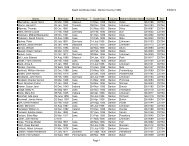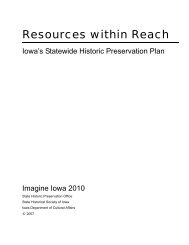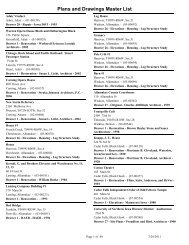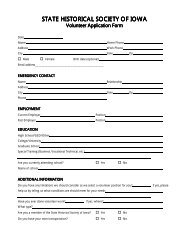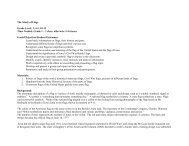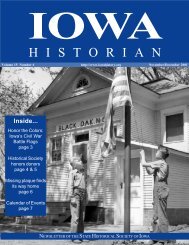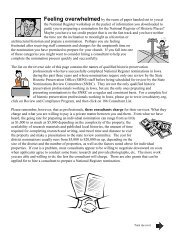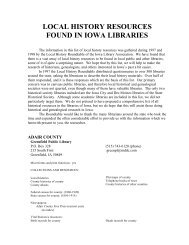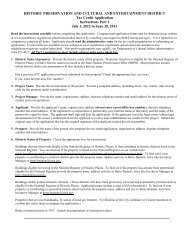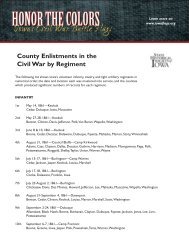H I S T O R I A N - State Historical Society of Iowa
H I S T O R I A N - State Historical Society of Iowa
H I S T O R I A N - State Historical Society of Iowa
You also want an ePaper? Increase the reach of your titles
YUMPU automatically turns print PDFs into web optimized ePapers that Google loves.
IOWA<br />
H I S T O R I A N<br />
Volume 15 Number 5 http://www.iowahistory.org September/October 2001<br />
Inside...<br />
History’s cool at The<br />
Museum School<br />
page 3<br />
Archaeology Month<br />
highlights<br />
page 4<br />
Students win with<br />
history<br />
page 5<br />
<strong>Historical</strong> libraries<br />
receive grant<br />
page 6<br />
Calendar <strong>of</strong> Events<br />
page 7<br />
<strong>Iowa</strong> Historian NEWSLETTER OF THE STATE HISTORICAL 1 SOCIETY OF IOWA September/October 2001
DEAR READERS...<br />
by Sarah Oltrogge, editor<br />
<strong>Iowa</strong>’s heritage surrounds us; it’s an unavoidable<br />
fact. Whether you’re walking in downtown<br />
Des Moines or strolling along Main Street in<br />
Algona, history is there.<br />
Now a little Internet company called<br />
ePodunk.com has recognized <strong>Iowa</strong>’s treasures <strong>of</strong><br />
history and ranked its most historic small towns. SARAH<br />
Number one on the list is Guttenberg, located along OLTROGGE<br />
the Mississippi River in northeast <strong>Iowa</strong>. The town<br />
was named for Johannes Gutenberg, the printer credited with the<br />
invention <strong>of</strong> the movable type. With a population <strong>of</strong> 2,238, Guttenberg<br />
is home to the Bluff Street Historic District, the Guttenberg National<br />
Fish Hatchery and Aquarium Historic District and the Lockmaster’s<br />
House Heritage Museum.<br />
The criteria used to rank these historic towns are the number <strong>of</strong><br />
buildings listed on the National Register <strong>of</strong> Historic Places in a<br />
county, the size <strong>of</strong> National Register Historic Districts in a county,<br />
the age <strong>of</strong> a county’s housing and the number <strong>of</strong> county projects<br />
awarded a federal preservation tax credit.<br />
Towns that made the cut were nonmetropolitan and had fewer<br />
than 100,000 residents. Across the country, 138 wonderful destinations<br />
for historic travelers in every state (except Alaska, Hawaii and<br />
North Dakota) are featured.<br />
If you didn’t have a chance to travel the state this summer, take<br />
advantage <strong>of</strong> the fall foliage and head to the river and visit some <strong>of</strong><br />
<strong>Iowa</strong>’s other historic towns that made the list:<br />
Dubuque–Pop. 56,742, named for Julien Dubuque, early settler.<br />
Visit the Mathias Ham House Historic Site, Mississippi River Museum<br />
and many historic districts.<br />
Maquoketa–Pop. 6,156, named for the Meskwaki term for bears.<br />
Home to Jackson County <strong>Historical</strong> <strong>Society</strong> and several historic<br />
districts.<br />
Burlington–Pop. 26,585, named after Burlington, Vt. See the Apple<br />
Trees Museum, Hawkeye Log Cabin and Phelps House.<br />
Also making the list are Ottumwa, Oskaloosa, West Branch and<br />
Kimballton. For more information, visit www.epodunk.com.<br />
IOWA<br />
HISTORIAN<br />
is published bimonthly as a benefit<br />
for members <strong>of</strong> the<br />
<strong>State</strong> <strong>Historical</strong> <strong>Society</strong> <strong>of</strong> <strong>Iowa</strong><br />
<strong>Society</strong> Board <strong>of</strong> Trustees<br />
Thomas Colbert, Marshalltown<br />
Therese (Teri) Goodman, Dubuque<br />
Galen Jackson, Rock Rapids<br />
Gail Sands, Cedar Falls<br />
Terri McMurtry-Chubb,<br />
Des Moines<br />
Rosalyn Middleton, Waterloo<br />
Robert Neymeyer, Parkersburg<br />
Walter W. Pyper, Council Bluffs<br />
Dorothy Schwieder, Ames<br />
Joseph Walt, Indianola<br />
Peggy Whitworth, Cedar Rapids<br />
Sarah Oltrogge<br />
Newsletter Editor<br />
Phone: 515-281-4011<br />
To help <strong>Iowa</strong>ns<br />
comprehend who they are and<br />
what they can become, the<br />
<strong>State</strong> <strong>Historical</strong> <strong>Society</strong> <strong>of</strong> <strong>Iowa</strong><br />
serves as a trustee <strong>of</strong> <strong>Iowa</strong>’s<br />
historical legacy and an<br />
advocate for understanding<br />
<strong>Iowa</strong>’s past.<br />
The mission <strong>of</strong> the<br />
<strong>Iowa</strong> <strong>Historical</strong> Foundation<br />
is to raise funds to support the<br />
<strong>State</strong> <strong>Historical</strong> <strong>Society</strong> <strong>of</strong> <strong>Iowa</strong><br />
and its programs,<br />
to preserve <strong>Iowa</strong>’s heritage and<br />
to educate <strong>Iowa</strong> citizens<br />
so that they know and<br />
appreciate that heritage.<br />
www.iowahistory.org<br />
<strong>Iowa</strong> <strong>Historical</strong> Foundation<br />
Chairman<br />
John Merriman, Clive<br />
Board <strong>of</strong> Directors<br />
Hal Chase, Des Moines<br />
Meg Courter, Des Moines<br />
Jim Foster, Des Moines<br />
Howard Gregory, Des Moines<br />
Luther L. Hill Jr., Des Moines<br />
Fred Lorber, Des Moines<br />
Sen. Gene Maddox, Clive<br />
Paul J. Meginnis II, Des Moines<br />
Rosalyn Middleton, Waterloo<br />
Tom Morain, Lamoni<br />
Liz Neumann, Des Moines<br />
Robert Neymeyer, Parkersburg<br />
William Peverill, Des Moines<br />
LeRoy Pratt, Des Moines<br />
Gary Reiners, Des Moines<br />
Mary Ann Zug, Des Moines<br />
© 2001 SHSI,<br />
a division <strong>of</strong> the<br />
Department<br />
<strong>of</strong><br />
Cultural Affairs<br />
New faces in the<br />
<strong>Society</strong>’s archives<br />
Two new people have joined the <strong>State</strong> <strong>Historical</strong> <strong>Society</strong> <strong>of</strong> <strong>Iowa</strong><br />
Archives Bureau in Des Moines.<br />
Jackie Perry joined SHSI last spring after completing a master’s<br />
degree in library and information science at the University <strong>of</strong> Pittsburgh<br />
in December. As assistant<br />
state archivist, Perry<br />
works with government<br />
records and serves as liaison<br />
between the <strong>State</strong> Archives<br />
and Records Bureau and specific<br />
state agencies on records<br />
issues. She will be working on<br />
grants and policy issues for<br />
electronic records. In July, she<br />
gave a presentation in her<br />
hometown <strong>of</strong> Bloomfield on<br />
<strong>Historical</strong> Resource Development<br />
Program grants for documentary<br />
collections (and was<br />
delighted to see so many familiar<br />
faces!).<br />
Perry’s previous experience<br />
includes work with contracts<br />
and records management issues<br />
for the Law Department<br />
at Bayer Corporation, creating<br />
cataloging procedures for the<br />
Archives Photo Collection at the Andy Warhol Museum, and encoding<br />
archival finding aids for the Internet at the Digital Research<br />
Library at the University <strong>of</strong> Pittsburgh. She also has a strong fine<br />
arts background in painting.<br />
Kristen Langstraat also joined the archives staff this spring. She<br />
is a recent graduate from Luther College in Decorah. Langstraat<br />
began working with the F. M. Hubbell Trust collection as an archives<br />
associate on June 1 and will be working to assist Christina<br />
Schmidt to prepare the collection. The project is expected to last for<br />
two more years. Langstraat is working to add recently acquired<br />
Hubbell family materials to the basic computerized inventory <strong>of</strong> the<br />
entire collection.<br />
About the Cover<br />
Kristen Langstraat and Jackie<br />
Perry are two additions to the<br />
<strong>Society</strong>’s Archives Bureau.<br />
This month’s cover photo depicts Alice Wiley, a third and fourth<br />
grade teacher, who is giving a lesson in geography in her railroad<br />
car schoolroom in Troy Mills.<br />
The school district found itself in a bind in 1937 when the previous<br />
school building burned that spring, and come fall, a new building<br />
hadn’t yet been started, even though a grant for $23,850 had<br />
been approved for a new building.<br />
Much like the people in this issue’s article on The Museum<br />
School, Troy Mills education <strong>of</strong>ficials had to be creative about<br />
where they housed students temporarily. Abandoned railroad cars<br />
apparently made the grade.<br />
2<br />
<strong>Iowa</strong> Historian September/October 2001
History’s cool at<br />
The Museum School<br />
Annals <strong>of</strong> <strong>Iowa</strong> focuses on<br />
early civil rights issues in <strong>Iowa</strong><br />
The summer issue <strong>of</strong> the Annals <strong>of</strong> <strong>Iowa</strong> features two articles on<br />
civil rights activities in unlikely places in <strong>Iowa</strong> in the 1940s, long<br />
before the better-known activities <strong>of</strong> the late 1950s and 1960s.<br />
George William McDaniel writes about a legal case brought by<br />
two prominent African Americans in Davenport in 1945 who were<br />
denied service at a local ice cream parlor. Their case provided an<br />
early test <strong>of</strong> an amendment to <strong>Iowa</strong>’s Civil Rights Act designed to<br />
make it easier to prosecute violations <strong>of</strong> the law.<br />
In the other article, Katrina Sanders describes the motivations<br />
and context that led African Americans and a few white citizens to<br />
partner with Fisk University in completing a survey <strong>of</strong> race relations<br />
in Burlington from 1949 to 1951. That survey revealed discriminatory<br />
practices in Burlington, initiated dialogue about race relations,<br />
provided an opportunity for whites to participate in constructive<br />
community action associated with civil rights, and supplied data<br />
that resulted in positive changes in the community.<br />
QUOTABLE:<br />
“We are anxious to demonstrate the benefits<br />
<strong>of</strong> learning outside the traditional classroom,<br />
among the experts and artifacts.”<br />
—Jan Drees, principal,<br />
The Downtown School<br />
The <strong>Iowa</strong> <strong>Historical</strong> Museum is <strong>of</strong>fering much more than a field<br />
trip opportunity for the Des Moines Downtown School while it<br />
hosts 100 students and their teachers for a month, transforming<br />
itself into The Museum School.<br />
The second through fifth grade students arrived at the building<br />
Aug. 20, and are staying for four weeks while renovations to expand<br />
their building are completed. Klark Jessen, spokesman for the<br />
Des Moines Public Schools, said this first-ever opportunity in <strong>Iowa</strong><br />
to hold classes in the <strong>Historical</strong> Museum makes good sense.<br />
“Challenges early in the process caused the district to search for<br />
temporary alternatives while renovation is completed,” Jessen said.<br />
“And the <strong>Historical</strong> Building was a perfect fit in terms <strong>of</strong> location<br />
and education potential.”<br />
The Downtown School was featured in the September 1999 issue<br />
<strong>of</strong> Working Mother magazine as one <strong>of</strong> the “10 Best Schools for<br />
Today’s Family.” It <strong>of</strong>fers small class sizes, an integrated curriculum,<br />
multi-age classes, an extended school year, and two locations<br />
close to where parents work in downtown Des Moines.<br />
Jerome Thompson, museum bureau chief for the <strong>State</strong> <strong>Historical</strong><br />
<strong>Society</strong> <strong>of</strong> <strong>Iowa</strong>, said what can be learned from the resources provided<br />
by the museum spans all disciplines.<br />
“This is an exciting chance to use <strong>Iowa</strong> history as a framework<br />
for learning everything from literature to science,” Thompson said.<br />
“Students can learn in a place that houses the real stuff <strong>of</strong> history.<br />
We’ll be going way beyond the field trip.”<br />
Museum and other <strong>Society</strong> staff are doing everything possible to<br />
accommodate the children, teachers and parents involved in the<br />
school’s functions, while at the same time realizing that this is something<br />
that can be used as a model for other museum-school partnerships.<br />
“There’s a ton <strong>of</strong> resources we can <strong>of</strong>fer the teachers,” Thompson<br />
said. “To me, the important thing is that this is an opportunity<br />
to pilot and we will be evaluating it with the principal and our staff<br />
to see how things might change.”<br />
Other museums have already shown interest in The Museum<br />
School, and museum and state government <strong>of</strong>ficials are invited to<br />
observe the children during their classes. Billie Bailey, executive<br />
director <strong>of</strong> the Grout Museum District in Waterloo, said the project<br />
will be a model for the entire state.<br />
“I’ll be sending my staff to observe this project to see if it is<br />
something we can do in Waterloo,” Bailey said.<br />
Principal Jan Drees said learning outside the classroom is fundamental<br />
to the mission <strong>of</strong> the Downtown School.<br />
“We are thrilled to have the opportunity for Downtown School<br />
students to start the school year at the <strong>Historical</strong> Building,” Drees<br />
said. “We are anxious to demonstrate the benefits <strong>of</strong> learning outside<br />
the traditional classroom, among the experts and artifacts. The<br />
<strong>Iowa</strong> <strong>State</strong> <strong>Historical</strong> Building is a wonderful resource and we can’t<br />
quite believe our good fortune to be able to take up residency in<br />
such a stimulating learning environment. My challenge will be to<br />
make this unique learning experience available to all our students in<br />
the future and to show others the possibilities.”<br />
The museum has ample space for the students and the building<br />
remains open for visitors and for other normal business while the<br />
students are here.<br />
<strong>Iowa</strong> projects win AASLH<br />
award<br />
The American Association for <strong>State</strong> and Local History will recognize<br />
the winners <strong>of</strong> its 56th Annual Awards Program during a special<br />
banquet Sept. 13 in Indianapolis.<br />
The Awards Program is the most prestigious recognition for achievement<br />
in the preservation and interpretation <strong>of</strong> local and state history.<br />
This year, the students and teachers <strong>of</strong> Central Alternative High<br />
School in Dubuque will receive the Award <strong>of</strong> Merit for the project,<br />
“A Tribute to Victory: Dubuque in World War II.” The <strong>State</strong> <strong>Historical</strong><br />
<strong>Society</strong> <strong>of</strong> <strong>Iowa</strong> will receive a Certificate <strong>of</strong> Commendation for<br />
the exhibit, “A Few <strong>of</strong> Our Favorite Things: 100 Creations <strong>of</strong> the<br />
20th Century.”<br />
The awards program was initiated in 1945 to establish and encourage<br />
standards <strong>of</strong> excellence in the collection, preservation and<br />
interpretation <strong>of</strong> state and local history throughout America.<br />
3<br />
<strong>Iowa</strong> Historian September/October 2001
Lib<br />
rary<br />
ner<br />
cor<br />
The Des Moines <strong>Historical</strong><br />
Library has a unique collection<br />
<strong>of</strong> biographical information on<br />
<strong>Iowa</strong> legislators from around<br />
1836 to the present.<br />
The Legislative File provides<br />
patrons with information concerning<br />
present and past senators<br />
and representatives <strong>of</strong><br />
<strong>Iowa</strong>. The information contains<br />
birth and death dates, major life<br />
experiences, and data about<br />
family members. A variety <strong>of</strong><br />
reference sources are examined<br />
to obtain this information, such<br />
as Wor Progress Administration<br />
(WPA) cemetery records,<br />
county histories, census data<br />
and county records.<br />
In 1970, Jon Robison, then<br />
administrative assistant for the<br />
<strong>State</strong> <strong>Historical</strong> <strong>Society</strong> <strong>of</strong> <strong>Iowa</strong>,<br />
created this file to address numerous<br />
questions concerning<br />
early legislators. We now have<br />
an alphabetical list <strong>of</strong> approximately<br />
2,000 state representatives<br />
and senators.<br />
Several staff and volunteer<br />
researchers continue to attempt<br />
to establish dates <strong>of</strong> death, and<br />
to locate obituaries that might<br />
contain information to complete<br />
the legislator’s vital data.<br />
Volunteers working on the<br />
Legislative File are Edward<br />
Hayes, Helen Whannel, Erma<br />
Fry and Helen Sneller, all <strong>of</strong> Des<br />
Moines.<br />
“Part <strong>of</strong> the fun and fascination<br />
<strong>of</strong> the legislative project for<br />
me was in discovering the persons<br />
involved and their families,”<br />
Hayes said.<br />
“One legislator, who later retired<br />
to Florida with his wife,<br />
returned to Audubon after she<br />
died,” he continued. “He was<br />
living in a retirement home<br />
Baker brings Native American perspective<br />
to Lewis and Clark Bicentennial<br />
Gerard Baker, superintendent<br />
<strong>of</strong> the “Corps <strong>of</strong> Discovery II:<br />
200 Years to the Future”<br />
project, will<br />
speak at the <strong>State</strong><br />
<strong>Historical</strong> Building<br />
Saturday, Sept. 22,<br />
from 2 to 3 p.m. in<br />
celebration <strong>of</strong> <strong>Iowa</strong><br />
Archaeology<br />
Month.<br />
Baker is a fullblood<br />
member <strong>of</strong> the Three Affiliated<br />
Tribes, which include the<br />
Mandan, Hidatsa and Arikara.<br />
His presentation, “We Saw Them<br />
Coming: An Indian Perspective<br />
<strong>of</strong> the Voyage <strong>of</strong> Discovery,” will<br />
focus on the Lewis and Clark expedition<br />
and how it affected Native<br />
Americans in the early 19th<br />
century.<br />
Corps <strong>of</strong> Discovery II is a<br />
project conducted by the National<br />
Park Service to commemorate<br />
the bicentennial <strong>of</strong> the Lewis<br />
and Clark expedition, scheduled<br />
for years 2003 to 2006.<br />
Baker is a key<br />
management <strong>of</strong>ficial<br />
working with other<br />
federal and state<br />
agencies, private<br />
industry and diverse<br />
communities.<br />
Under his leadership<br />
as superintendent,<br />
Corps <strong>of</strong> Discovery<br />
II will recreate the epic<br />
journey <strong>of</strong> Meriwether Lewis and<br />
William Clark by retracing the<br />
historic trail, crossing 19 states,<br />
including <strong>Iowa</strong>, and following in<br />
the footsteps <strong>of</strong> these explorers.<br />
“I’ve always been interested<br />
in not only my culture, but in the<br />
explorers who followed the Missouri<br />
River,” Baker said. “All <strong>of</strong><br />
the explorers came through Indian<br />
country, so the opportunity<br />
now exists to bring the tribes on<br />
board and give them an opportunity<br />
to tell their part <strong>of</strong> the<br />
story.”<br />
Baker attended school on the<br />
Fort Berthold Indian Reservation<br />
at Mandanee, N.D., and graduated<br />
from St. Mary’s High School in<br />
New England, N.D. He graduated<br />
in 1979 from Southern Oregon<br />
<strong>State</strong> University with degrees in<br />
criminology and sociology.<br />
Baker began his career with the<br />
National Park Service in 1979, and<br />
worked for the U.S. Forest Service<br />
before returning to the NPS<br />
as superintendent <strong>of</strong> Little Big<br />
Horn Battlefield National Monument<br />
in Crow Agency, Mont. In<br />
1998, he became superintendent<br />
<strong>of</strong> Chickasaw National Recreation<br />
Area in Oklahoma, and received<br />
the U.S. Department <strong>of</strong> the<br />
Interior’s Honor Award for Superior<br />
Service.<br />
Baker currently lives in Omaha.<br />
Dig In: Archaeology Month events feature Fort Des<br />
Moines II and Dallas County site<br />
September is <strong>Iowa</strong> Archaeology<br />
over 50 volunteers, including Moines II. The site also contains<br />
Month, and to celebrate, the many residents <strong>of</strong> Polk and Dal-<br />
evidence <strong>of</strong> an Oneota encamp-<br />
<strong>State</strong> <strong>Historical</strong> <strong>Society</strong> <strong>of</strong> <strong>Iowa</strong> las counties, has added to the ment and <strong>of</strong> the earliest commercial<br />
has lined up fascinating topics chapter in the story <strong>of</strong> <strong>Iowa</strong> a<br />
and residential development<br />
on <strong>Iowa</strong> archaeological projects. millennium ago.<br />
in the town <strong>of</strong> Fort Des Moines.<br />
On Saturday, Sept. 8 at 10 a.m., Alex will present the new discoveries<br />
Also on Sept. 15, Eric Ander-<br />
Lynn Alex <strong>of</strong> the Office <strong>of</strong> the<br />
made while working on son, city manager for the City <strong>of</strong><br />
<strong>State</strong> Archaeologist will present the project, and give information Des Moines, will lead a discussion<br />
“1000 Years Ago in Dallas on how others can take part in<br />
about the long-term preser-<br />
County, <strong>Iowa</strong>: Archaeological uncovering <strong>Iowa</strong>’s archaeological<br />
vation and interpretation <strong>of</strong> the<br />
Findings at the Maxwell Site.”<br />
past.<br />
site. Sponsors <strong>of</strong> the presentavation<br />
One thousand years ago, Native<br />
On Saturday, Sept. 15 from10 tion are the <strong>State</strong> <strong>Historical</strong> Socited<br />
American communities dot-<br />
a.m. to noon, Randall Withrow ety <strong>of</strong> <strong>Iowa</strong>, Central <strong>Iowa</strong> Chap-<br />
the valleys <strong>of</strong> the Des and Chris Schoen <strong>of</strong> The Louis ter <strong>of</strong> the <strong>Iowa</strong> Archaeological<br />
Moines and Raccoon rivers in Berger Group, Inc. will present <strong>Society</strong>, the City <strong>of</strong> Des Moines,<br />
Central <strong>Iowa</strong>. Armed with the “Recent Discoveries at Fort Des and the Polk County <strong>Historical</strong><br />
bow and arrow, their inhabitants Moines II.” The Louis Berger <strong>Society</strong>.<br />
hunted deer, elk and smaller Group provides cultural resource<br />
The <strong>State</strong> <strong>Historical</strong> Building<br />
mammals; caught catfish and<br />
services for archaeologi-<br />
is located at 600 E. Locust in Des<br />
sucker; planted small gardens <strong>of</strong> cal projects and has a branch Moines. All Archaeology<br />
corn, squash and sunflowers; <strong>of</strong>fice located in Marion. Month activities, including<br />
continued on page 5 and made beautiful earthenware These archaeologists have Gerard Baker’s presentation, are<br />
pots. Summer excavation at the uncovered remnants <strong>of</strong> the free and open to the public. Call<br />
Maxwell Site in Dallas County by 1840s military post, Fort Des KC Hummel at (515) 281-6058 for<br />
4<br />
more information.<br />
<strong>Iowa</strong> Historian September/October 2001
<strong>Iowa</strong> girls take top score at<br />
national history event<br />
Two seventh-grade students from Indian Hills<br />
Junior High in Clive claimed victory by winning<br />
first place in the National History Day competition<br />
in June in Washington, D.C.<br />
Amy Paul and Katie Pauley won their top prize<br />
in the junior group documentary category with a<br />
project on scientist Barbara McClintock. The two<br />
had seen a newspaper article about a play written<br />
on McClintock, and thought the subject<br />
matter fit well with the National History Day<br />
theme, “Frontiers in History: People, Places,<br />
Ideas.”<br />
“I think what was really interesting to us was<br />
all the challenges and the obstacles she had to<br />
face,” Paul said. “She went to Cornell University,<br />
and at the time she was there, they didn’t<br />
allow women in the genetics department. And<br />
there were a lot <strong>of</strong> times people didn’t take her<br />
seriously becasue she was a woman.”<br />
McClintock is an American geneticist and<br />
Nobel laureate, most noted for her discovery that<br />
genes can transfer their positions on chromosomes,<br />
which is important for the understanding<br />
<strong>of</strong> hereditary processes.<br />
Of 3,000 History Day participants last spring,<br />
Paul and Pauley were among 45 <strong>Iowa</strong> junior and<br />
senior high students who advanced to the national<br />
competition. In Washington, Paul said they<br />
competed against 80 different projects. This is<br />
Day trip <strong>of</strong>fers chance to retrace Lewis and Clark Trail<br />
Anyone interested in learning<br />
more about the Lewis and<br />
Clark Expedition is invited to the<br />
Lewis and Clark Autumn Outing<br />
Motor Coach Day Trip<br />
scheduled for Saturday, Oct. 13.<br />
Cost for the day trip is $50<br />
per person. Registration is on<br />
a first-come, first-serve basis<br />
and the deadline is Thursday,<br />
Sept. 13. Ten spaces are being<br />
reserved for <strong>State</strong> <strong>Historical</strong><br />
<strong>Society</strong> <strong>of</strong> <strong>Iowa</strong> staff and volunteers.<br />
The outing is being organized<br />
by the Northeast Nebraska<br />
RC&D, as the bicentennial<br />
commemoration <strong>of</strong> the<br />
Lewis and Clark Trail nears. It<br />
will begin at the Corps <strong>of</strong> Discovery<br />
Welcome Center near<br />
Cr<strong>of</strong>ton, Neb., at 8:30 a.m. The<br />
RC&D is holding 10 spaces for<br />
SHSI staff and volunteers,<br />
though more may be added if<br />
the first time in the eight years History Day has<br />
been sponsored by the <strong>State</strong> <strong>Historical</strong> <strong>Society</strong> <strong>of</strong><br />
<strong>Iowa</strong> that an <strong>Iowa</strong> project has won first place at the<br />
national level.<br />
“I was surprised,” Paul said. “It was just an honor<br />
to go to nationals. After watching the run-<strong>of</strong>fs, we<br />
weren’t sure how we would do because they’re all<br />
very good at that level.”<br />
“We didn’t exactly expect it but we had worked to<br />
try to get there the whole way, so it was pretty fun<br />
to get it,” Pauley added.<br />
Governor Tom Vilsack and Lt. Governor Sally<br />
Pederson awarded Amy Paul, left, and Katie Pauley<br />
with gold medals and a check for $1,000 for winning<br />
the National History Day competition in June.<br />
needed. Carpools may be arranged<br />
for travel to Cr<strong>of</strong>ton in<br />
order to keep expenses down.<br />
The itinerary is as follows:<br />
Lewis and Clark Visitor’s<br />
Center–Calumet Bluff near<br />
Gavin’s Point Dam, South Dakota.<br />
Spirit Mound–The explorers<br />
visited here after hearing from<br />
Native Americans that it was<br />
haunted by ghosts.<br />
W. H. Over Museum–Located<br />
on the campus <strong>of</strong> the University<br />
<strong>of</strong> South Dakota.<br />
Elk Point, S.D.–Site <strong>of</strong> the first<br />
American election (Patrick Gass<br />
promoted to sergeant through<br />
election after Sergeant Floyd’s<br />
death).<br />
Sergeant Floyd River Museum,<br />
Sioux City–Sgt. Floyd<br />
was the only member <strong>of</strong> the expedition<br />
to die on the journey.<br />
Ponca <strong>State</strong> Park–Lewis and<br />
Clark passed through this part<br />
<strong>of</strong> the river in August 1804. Incredible<br />
3-state overlook <strong>of</strong> the<br />
Missouri River valley.<br />
Ionia Volcano–Lewis and<br />
Clark’s journals told <strong>of</strong> a blue<br />
clay bluff that appeared to be<br />
on fire and too hot for a man to<br />
bury his hand in the earth at<br />
any depth.<br />
Wiseman Monument–This<br />
marks the area where tribal hostilities<br />
took place in 1863.<br />
Brookey Bottom–Park and<br />
recreation area along the Missouri<br />
River and Lewis and Clark<br />
Trail.<br />
Back to Corps <strong>of</strong> Discovery<br />
Welcome Center, about 6:30<br />
p.m., and finally back to Des<br />
Moines.<br />
For more information or a<br />
registration form, call KC<br />
Hummel at (515) 281-6058.<br />
Lib<br />
rary<br />
ner<br />
cor<br />
from page 4<br />
there,<br />
<strong>Iowa</strong><br />
age<br />
City<br />
101, when<br />
Library<br />
he had his<br />
first balloon ride. A county history<br />
<strong>of</strong> Linn County described<br />
the heroic exploits <strong>of</strong> a lawyerbanker<br />
<strong>of</strong> Marion and Cedar<br />
Rapids, and then explained how<br />
later, with the help <strong>of</strong> his<br />
friends, a former law partner he<br />
opposed was denied the Republican<br />
nomination for Congress.<br />
“While many legislators remained<br />
in their home areas after<br />
leaving the legislature, a<br />
number could be found in<br />
county histories, death records<br />
or cemetery listings. Some<br />
county histories do record that<br />
persons have moved to a new<br />
home. It was a challenge to try<br />
to locate the others–not always<br />
successfully met.<br />
“The project provided insights<br />
into <strong>Iowa</strong> history and<br />
information about many people<br />
who played significant parts in<br />
that history,” Hayes added.<br />
Sometimes a request for information<br />
about a legislator<br />
benefits our library as well. Recently,<br />
a church archives in<br />
Canada requested information<br />
about the later years <strong>of</strong> Benjamin<br />
Spencer, a person they<br />
believed had been elected to the<br />
<strong>Iowa</strong> legislature after he moved<br />
to this state from Ontario. We<br />
were able to provide the church<br />
with information on Representative<br />
Spencer’s life in <strong>Iowa</strong>, and<br />
in return, we received information<br />
that we didn’t have about<br />
his early years in Canada.<br />
The Legislative File is available<br />
for research during the<br />
library’s regular hours: Tuesday-Saturday,<br />
9 a.m.-4:30 p.m.<br />
at the <strong>Historical</strong> Building, 600<br />
E. Locust, Des Moines. Call<br />
515-281-6200 for information.<br />
5<br />
<strong>Iowa</strong> Historian September/October 2001
Carver Trust helps <strong>Historical</strong><br />
Library collection go online<br />
The card catalog at the <strong>State</strong><br />
<strong>Historical</strong> <strong>Society</strong>’s Libraries will<br />
be brought into the 21st century<br />
by going online, with the help <strong>of</strong><br />
a $141,198 grant from the Roy J.<br />
Carver Charitable Trust.<br />
The grant will fund the first<br />
year <strong>of</strong> work to automate the card<br />
catalog at the <strong>State</strong> <strong>Historical</strong> Libraries<br />
in <strong>Iowa</strong> City and Des<br />
Moines. The libraries’ holdings<br />
will then be accessible through<br />
a click <strong>of</strong> the mouse.<br />
“The biggest advantage <strong>of</strong> an<br />
automated catalog is that anyone<br />
anyplace in the world who<br />
has access to the Internet will be<br />
able to find out what we have in<br />
our library,” said Paula Smith,<br />
catalog librarian in <strong>Iowa</strong> City.<br />
The <strong>Society</strong>’s holdings will be<br />
included as an independent database<br />
in the University <strong>of</strong><br />
<strong>Iowa</strong>’s online system, InfoHawk.<br />
Access will be made available<br />
within the next 15 months<br />
through the <strong>Society</strong>’s Web site,<br />
www.iowahistory.org, as well as<br />
through the University <strong>of</strong> <strong>Iowa</strong><br />
Libraries’ Web site,<br />
www.uiowa.edu/homepage/libraries,<br />
and eventually through<br />
other sites.<br />
“We are incredibly<br />
grateful<br />
for this lead gift<br />
from the Carver<br />
Trust which will<br />
allow us to develop<br />
and implement<br />
an automated<br />
~ catalog<br />
system,” said<br />
S h a n e r<br />
Magalhaes, bureau<br />
chief for the<br />
<strong>State</strong> <strong>Historical</strong><br />
<strong>Society</strong> libraries.<br />
“We recognize that there is much<br />
work ahead, but with the Carver<br />
Trust grant in hand, we now have<br />
valuable match money for numerous<br />
grant programs that we<br />
could pursue in the near future.”<br />
<strong>Iowa</strong> is one <strong>of</strong> only 17 state<br />
historical societies without automated<br />
catalogs for their libraries.<br />
Online access will improve<br />
the visibility <strong>of</strong> the libraries’<br />
holdings and likely increase the<br />
use <strong>of</strong> the col-<br />
QUOTABLE:<br />
“Having access to an<br />
online catalog reflecting<br />
the holdings <strong>of</strong> the<br />
<strong>Society</strong>’s libraries will<br />
be a real bonus for<br />
researchers from all<br />
over the country.”<br />
—Shari Stelling,<br />
associate librarian<br />
lection by<br />
young researchers<br />
who use the<br />
Internet as a<br />
tool.<br />
“Having<br />
access to an<br />
online catalog<br />
reflecting<br />
the holdings<br />
<strong>of</strong> the <strong>Society</strong>’s<br />
libraries<br />
will be a<br />
real bonus for researchers from<br />
all over the country—as well as<br />
folks down the street from us—<br />
who won’t have to call or visit<br />
to find out whether we have a<br />
particular resource,” said Shari<br />
Stelling, library associate in Des<br />
Moines. “We’re very excited<br />
about finally getting our catalog<br />
online.”<br />
The Carver Charitable Trust, located<br />
in Muscatine, is the largest<br />
private foundation in the state <strong>of</strong><br />
<strong>Iowa</strong>. It was created through the<br />
will <strong>of</strong> Roy J. Carver, a Muscatine<br />
industrialist and philanthropist<br />
who died in 1981. The Trust awards<br />
more than $14 million annually in<br />
support <strong>of</strong> scientific research,<br />
scholarships, libraries, general education<br />
and other issues related to<br />
the needs <strong>of</strong> <strong>Iowa</strong> youth.<br />
“We believe that a project <strong>of</strong><br />
this type is consistent with the<br />
Trust’s mission to improve and<br />
enhance educational opportunities<br />
within the state <strong>of</strong> <strong>Iowa</strong>, and<br />
should also serve to promote<br />
scholarly interest in our state’s<br />
rich and varied historical heritage,”<br />
said Dr. Lynne Sasmazer,<br />
program director for the Carver<br />
Trust.<br />
<strong>Iowa</strong> History Survey shows teachers need more resources<br />
A survey <strong>of</strong> <strong>Iowa</strong> history teachers conducted last spring shows<br />
an ever-present need for more and updated resource materials<br />
on the subject.<br />
“It pretty much confirmed what I knew about <strong>Iowa</strong> history<br />
teachers,” said Lynn Nielsen, pr<strong>of</strong>essor <strong>of</strong> education<br />
at the University <strong>of</strong> Northern <strong>Iowa</strong> who conducted the survey.<br />
“I knew that outdated material was a problem, but when I<br />
got to the material on textbooks, I was amazed at how many<br />
people were still using materials copyrighted in the sixties—some<br />
even before.”<br />
Of 1,250 teachers in K-8 public and private schools throughout<br />
the state, approximately 16 percent <strong>of</strong> the surveys were returned, a<br />
large enough sampling to get a feel for what teachers need in the<br />
area <strong>of</strong> <strong>Iowa</strong> history.<br />
Not only do teachers want updated materials, they also expressed<br />
a need for a packaged teaching unit that might include a curriculum<br />
guide, videos, instructional Web sites, and ideas for field trips and<br />
projects.<br />
“This survey confirms that there is a need for materials that teachers<br />
can use in teaching <strong>Iowa</strong> history,” said Jerome Thompson, museum<br />
bureau chief for the <strong>State</strong> <strong>Historical</strong> <strong>Society</strong> <strong>of</strong> <strong>Iowa</strong>. “The<br />
most important part <strong>of</strong> this is that we’ve got some baseline data to<br />
go by.”<br />
The survey couldn’t have come at a better time, Thompson said,<br />
as it ties in with one <strong>of</strong> the goals <strong>of</strong> Imagine <strong>Iowa</strong> 2010–to make<br />
<strong>Iowa</strong> a national leader in cultural education, and make teaching<br />
<strong>Iowa</strong> history an integral part <strong>of</strong> the educational curriculum.<br />
In fact, the ball is already rolling on updating educational<br />
materials–<strong>Iowa</strong> <strong>State</strong> University Press will be issuing<br />
a new edition <strong>of</strong> <strong>Iowa</strong> Past to Present: The People<br />
and the Prairie, by Dorothy Schwieder, Thomas Morain and<br />
Nielsen. The text was identified in the survey as the number one<br />
source <strong>of</strong> <strong>Iowa</strong> history information by teachers.<br />
“The challenge is getting the word out and getting teachers<br />
access to the materials,” Thompson said.<br />
Another promising result <strong>of</strong> the survey deals with field trips. As<br />
school districts tighten their budgets, Nielsen assumed field trips<br />
would be the first to go. Not so, he said.<br />
“You hear that field trips have been cut, but there were a lot <strong>of</strong><br />
<strong>Iowa</strong> history field trips,” he said. “At least in the area <strong>of</strong> <strong>Iowa</strong><br />
history, field trips have not been cut out.” The most popular trips<br />
identified were to Living History Farms in Urbandale, and the <strong>State</strong><br />
Capitol and the <strong>State</strong> <strong>Historical</strong> Museum in Des Moines.<br />
Most teachers who answered the survey also showed that <strong>Iowa</strong><br />
geography, early exploration and pioneer life received the greatest<br />
emphasis in their curriculum.<br />
“The bottom line on this thing is that teachers want some leadership<br />
in the teaching <strong>of</strong> <strong>Iowa</strong> history,” Nielsen said.<br />
6<br />
<strong>Iowa</strong> Historian September/October 2001
“1000 Years Ago in Dallas County, <strong>Iowa</strong>: Archaeological<br />
Findings at the Maxwell Site”<br />
Saturday, Sept. 8, 10 a.m., FREE<br />
<strong>State</strong> <strong>Historical</strong> Building, 600 E. Locust, Des Moines<br />
Join Lynn Alex <strong>of</strong> the Office <strong>of</strong> the <strong>State</strong> Archaeologist to<br />
hear about this project, see the new discoveries, and find<br />
out how you can take part in uncovering <strong>Iowa</strong>’s archaeological<br />
past.<br />
CALENDAR OF EVENTS<br />
We Saw Them Coming: An Indian Perspective <strong>of</strong> the Voyage <strong>of</strong><br />
Discovery<br />
Saturday, Sept. 22, 2-3 p.m. FREE<br />
<strong>State</strong> <strong>Historical</strong> Building, 600 E. Locust, Des Moines<br />
Baker is a full-blood member <strong>of</strong> the Three Affiliated Tribes which<br />
include the Mandan, Hidatsa, and Arikara. His presentation will<br />
focus on the Lewis and Clark Expedition and how it affected Native<br />
Americans in the early 19th century.<br />
Recent Discoveries at Fort Des Moines II<br />
Saturday, Sept. 15, 10 a.m.-noon, FREE<br />
<strong>State</strong> <strong>Historical</strong> Building Atrium, 600 E. Locust,<br />
Des Moines<br />
Come learn about the birthplace <strong>of</strong> the city <strong>of</strong> Des Moines.<br />
Archaeologists have uncovered remnants <strong>of</strong> the 1840s<br />
military post, Fort Des Moines II. The site also contains<br />
evidence <strong>of</strong> an Oneota encampment and <strong>of</strong> the earliest<br />
commercial and residential development in the Town <strong>of</strong> Fort<br />
Des Moines. Artifacts from the site will be on display<br />
during the presentation.<br />
Sunday afternoon lecture<br />
Sunday, Sept. 16, 2 p.m.<br />
Western Historic Trails Center, 3434 Richard Downing<br />
Avenue, Council Bluffs<br />
Sunday afternoon lecture hosted by the <strong>Historical</strong> <strong>Society</strong><br />
<strong>of</strong> Pottawattamie County. Call 515-366-4900.<br />
River City Round-Up<br />
Saturday and Sunday, Sept. 22 and 23<br />
Western Historic Trails Center, 3434 Richard Downing Avenue,<br />
Council Bluffs<br />
Demonstrations by the Mid-American Woodcarvers Association.<br />
Call 515-366-4900.<br />
Organ recital<br />
Sunday, Sept. 30, 2 p.m. FREE<br />
Union Sunday School, Clermont<br />
Call 319-423-7378.<br />
Fall Foliage Weekend<br />
Saturday and Sunday, Oct. 6 and 7<br />
Montauk, Clermont<br />
Fayette County Fall Foliage Weekend. Call 319-423-7173.<br />
Yes!<br />
I’m interested in becoming a member<br />
<strong>of</strong> the STATE HISTORICAL SOCIETY OF IOWA.<br />
Individual Membership $40<br />
✶ <strong>Iowa</strong> Heritage Illustrated magazine<br />
✶ <strong>Iowa</strong> Historian newsletter<br />
✶ 10% discount at Museum Store &<br />
Cafe<br />
✶ Time Travelers <strong>Society</strong><br />
✶ Exclusive member benefits<br />
Heritage Circle $100 & Over<br />
✶ Individual and family benefits<br />
✶ 20% discount on books at the Museum<br />
Store<br />
✶ Annals <strong>of</strong> <strong>Iowa</strong> scholarly journal<br />
✶ Premium <strong>Iowa</strong> history book<br />
✶ Special pre~opening access to new<br />
exhibits<br />
Family Membership<br />
Add $20 to the individual<br />
membership. If joining the<br />
Heritage Circle and desire family<br />
membership, check this box .<br />
Your family will enjoy the individual<br />
membership benefits plus:<br />
✶<br />
✶<br />
✶<br />
✶<br />
Special notice <strong>of</strong> family activities<br />
Membership cards for each<br />
member<br />
Kids’ events calendar &<br />
newsletter<br />
20% discount at the Museum<br />
Store on children’s books and<br />
toys<br />
Complete the form below and mail with<br />
your payment to:<br />
Membership Program<br />
600 East Locust<br />
Des Moines, IA 50319;<br />
515-242-5217<br />
Name:<br />
Address:<br />
Phone:<br />
Email:<br />
Check enclosed<br />
Credit Card: Visa/MasterCard accepted.<br />
Supporter Benefactor Patron Conservator Advocate (Please circle)<br />
$10,000 & Over $5,000 & Over $1,000 $500 & Over $250 & Over Name on Card:<br />
& Over<br />
Card #:<br />
Expiration Date:<br />
7<br />
<strong>Iowa</strong> Historian September/October 2001
IOWA<br />
HISTORIAN<br />
<strong>State</strong> <strong>Historical</strong> <strong>Society</strong> <strong>of</strong> <strong>Iowa</strong><br />
600 E. Locust<br />
Des Moines, IA 50319<br />
Pre-Sorted Standard<br />
U.S. Postage<br />
PAID<br />
Permit No. 1195<br />
Des Moines, IA<br />
IN YOUR WORDS<br />
by Dorothy Schwieder<br />
My husband and I recently<br />
moved to a townhouse, and as<br />
with every move, we now find<br />
ourselves in a somewhat different<br />
environment.<br />
Leaving behind a home surrounded<br />
with<br />
many tall trees<br />
and a rather small<br />
backyard, our<br />
townhouse complex<br />
is surrounded<br />
with a large,<br />
neatly tended expanse<br />
<strong>of</strong> lawn.<br />
Dorothy<br />
Schwieder<br />
An unexpected and delightful<br />
discovery, however, is a narrow<br />
swatch <strong>of</strong> prairie wetland, located<br />
just behind the townhouse<br />
complex. Looking out each day<br />
and seeing the tall prairie grass<br />
is a constant reminder that almost<br />
everywhere, even at our very<br />
doorsteps, we can find important<br />
remnants <strong>of</strong> the past.<br />
This setting has caused me to<br />
reflect once more on all our immediate<br />
surroundings, particularly<br />
in regard to our heritage as<br />
<strong>Iowa</strong>ns. Having taught history<br />
for 34 years at <strong>Iowa</strong> <strong>State</strong> University,<br />
which included a yearly<br />
course in <strong>Iowa</strong> history, I have<br />
come to appreciate the historical<br />
treasures that exist here. Like<br />
many others, I have come to understand<br />
that in <strong>Iowa</strong>, as elsewhere,<br />
history is everywhere.<br />
We need only to look around<br />
to see how many valuable resources<br />
we have at our very fingertips.<br />
These local resources are<br />
important for all age groups, but<br />
I think the most important for elementary<br />
school children. What<br />
better way to study <strong>Iowa</strong> history,<br />
for example, than by learning<br />
about one’s immediate heritage<br />
such as the surrounding physical<br />
environment, local architectural<br />
styles, and the history <strong>of</strong><br />
our communities and community<br />
institutions These phenomena<br />
can be experienced in a firsthand<br />
manner. As one elementary<br />
<strong>Iowa</strong> history teacher put it recently:<br />
Children learn so much<br />
better when they can see, touch<br />
and feel the subject matter.<br />
As <strong>Iowa</strong>ns, I believe we<br />
should all do more to help our<br />
young people appreciate their<br />
local communities as well as<br />
statewide resources. I believe<br />
every age group should understand<br />
the past, not only in a national<br />
sense, but also in terms <strong>of</strong><br />
the immediate.<br />
So <strong>of</strong>ten when school children<br />
study history, the emphasis is on<br />
places and happenings far away.<br />
I believe we have the responsibility<br />
as educators, parents, and<br />
concerned citizens to emphasize<br />
that the resources at our very<br />
doorsteps make for important,<br />
interesting and exciting history.<br />
This approach should generate<br />
many rewards as young people<br />
come to understand and appreciate<br />
the importance <strong>of</strong> their own<br />
heritage.<br />
Today there is much concern<br />
about young people leaving this<br />
state. While there are many views<br />
on what should be done to make<br />
<strong>Iowa</strong> a more appealing and exciting<br />
place to live, one more way is<br />
to help develop an increasing interest<br />
in, and appreciation <strong>of</strong>, local<br />
history and culture.<br />
We already have so many excellent<br />
museums and organizations<br />
engaged in the preservation<br />
and interpretation <strong>of</strong> our past, perhaps<br />
what is needed is to emphasize<br />
even more strongly the link<br />
between existing historical institutions<br />
and the public schools. It<br />
should be pointed out that the<br />
<strong>State</strong> <strong>Historical</strong> <strong>Society</strong> <strong>of</strong> <strong>Iowa</strong><br />
has already developed many fine<br />
programs for youngsters including<br />
a curriculum guide for <strong>Iowa</strong><br />
history teachers. The guide includes<br />
suggestions to help teachers<br />
incorporate local history material<br />
into their course work. An<br />
exciting new adventure is The<br />
Museum School highlighted in<br />
this issue. In addition to studying<br />
their regular courses, students<br />
will learn about <strong>Iowa</strong> and<br />
Des Moines history, making use<br />
<strong>of</strong> the museum’s exhibits and artifacts.<br />
As <strong>Iowa</strong>ns, we are fortunate<br />
to have local historical resources<br />
that are varied, interesting, and<br />
accessible. Let’s help our children<br />
and grandchildren learn to<br />
understand and appreciate these<br />
wonderful resources.<br />
Dorothy Schwieder is pr<strong>of</strong>essor<br />
emerita <strong>of</strong> history at <strong>Iowa</strong> <strong>State</strong> University,<br />
where she taught courses in<br />
<strong>Iowa</strong> history. She is also chairperson<br />
<strong>of</strong> the <strong>State</strong> <strong>Historical</strong> <strong>Society</strong> <strong>of</strong><br />
<strong>Iowa</strong> Board <strong>of</strong> Trustees.<br />
If you’d like to be considered for<br />
the guest column, please contact Sarah<br />
Oltrogge at 515-281-4011 by<br />
Oct. 1.




